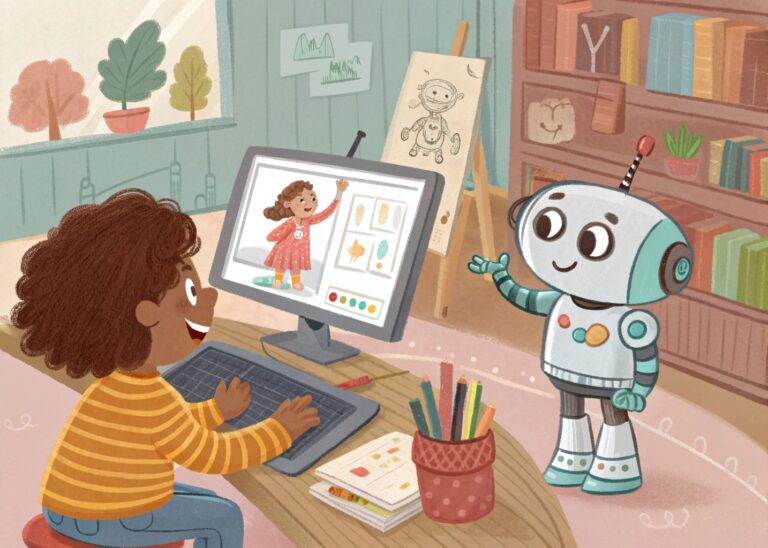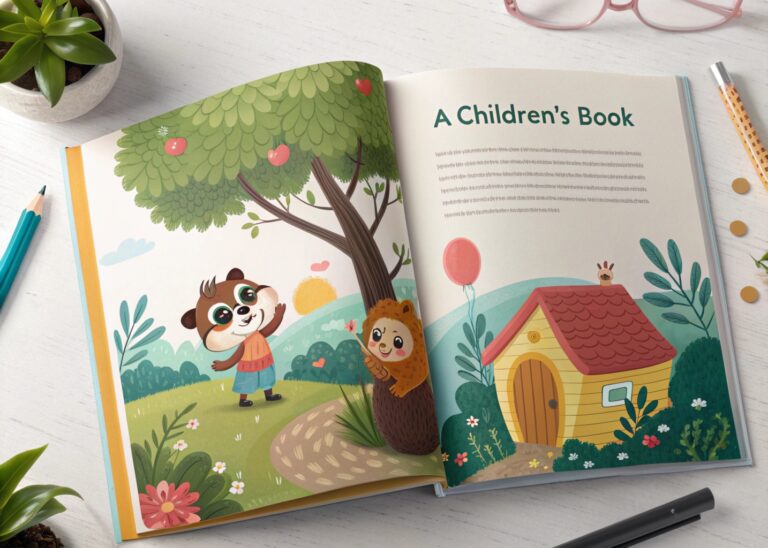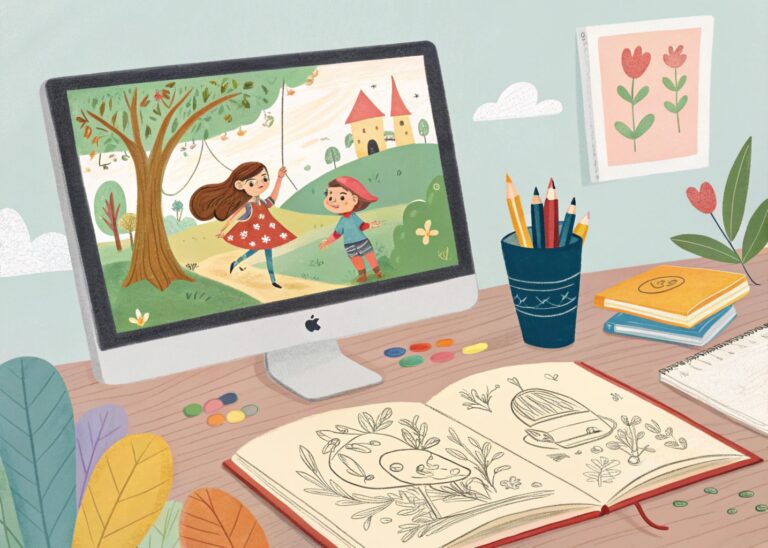Since 2024, artificial intelligence has radically changed children’s book creation, transforming what was traditionally an 18-24 month process into a highly-streamlined efficient and semi-automated workflow that can be completed in as little as two weeks. This comprehensive guide will walk you through the technical process of creating your own children’s book using state-of-the-art AI tools.
The integration of AI in children’s book creation is indeed an entire paradigm shift in publishing, after major companies have granted access to tools previously reserved for established publishing houses. This technological transformation has enabled independent authors to compete with traditional publishers while maintaining high production values and creative control.
The rapid development and improvement of generative AI technologies has particularly impacted the illustration process, historically the most time-consuming and expensive aspect of children’s book production. Modern AI tools now can generate complex, stylistically consistent artwork in minutes, though expertise in prompt engineering and post-processing remains an important aspect for professional results which is still dependent on human skill.
Writing Children’s Book With AI: Technical Requirements
Core AI Tools
- GPT-4 or Claude for text generation
- Midjourney v6 for illustration creation
- Adobe Photoshop or similar for image refinement
- Optional: Riffusion for audio elements
The selection of these specific AI tools reflects years of rapid development in the fields of natural language processing and image generation. These platforms are not the only options out there on the market – but these specifically have emerged as industry leaders due to their sophisticated understanding of narrative structure and visual consistency requirements specific to children’s literature.
In terms of creating a children’s book, the combination of multiple AI systems creates a synergistic workflow where each tool’s strengths complement the others. Text generation models work best at understanding age-appropriate vocabulary and narrative pacing, while image generation systems have been specifically trained on illustration styles suitable for young audiences.

Modern AI tools greatly facilitate nearly all creative processes. For example, you don’t need to be a digital artist to create illustrations; a carefully engineered AI prompt will result in nicely designed illustrations.
Book Specifications
- Standard formats: 7.5″ x 7.5″, 7″ x 10″, 10″ x 8″, or any other standard dimensions
- Image resolution: 300 DPI minimum
- Page count: 32-40 pages including front matter (depending on your individual preferences)
- Color space: CMYK for print
These specifications have evolved from decades of research into child development and reading behaviors. The chosen formats optimize for both lap reading and group storytelling scenarios, while the page count aligns with attention span research for different age groups.
The technical requirements for children’s book print quality are an important factor in producing books for young readers. Higher resolution and precise color management are crucial as children often interact with books more physically than adult readers, which is why you need to ensure durability in both print and color retention.
Step 1: Story Generation (Estimated time: 1-2 days)
- Access GPT-4 through ChatGPT or Claude through Anthropic
- Initial prompt structure:
Write a children's story that:
- Targets age group [X-Y]
- Contains [specific themes]
- Features [character types]
- Includes [number] scenes for illustration - Refinement process:
- Request character development iterations
- Adjust pacing and dialogue
- Optimize page breaks for illustration placement
The art of prompt engineering for children’s literature requires understanding both the capabilities of AI language models and the unique requirements of young readers. Modern AI systems have been trained on vast collections of children’s literature, enabling them to understand and replicate age-appropriate vocabulary and narrative structures.
The iterative process of story refinement mirrors traditional editorial workflows but operates at significantly accelerated speeds. AI models can generate multiple variations of scenes or character interactions, allowing authors to quickly explore different narrative approaches while maintaining consistency in voice and theme.
Step 2: Illustration Creation (Estimated time: 5-7 days)
- Midjourney Setup:
- Join Discord server
- Subscribe to the paid plan for commercial rights
- Enable private messaging for dedicated workspace
- Prompt Engineering for Consistent Style:
[Scene description] + Style: children's book illustration
Medium: [watercolor/digital/etc.]
Character details: [specific traits]
Atmosphere: [mood/lighting]
--ar [aspect ratio] --v 6 - Image Refinement:
- Export at 300 DPI minimum
- Process through Photoshop for:
- Color correction
- Style consistency
- Character uniformity
- Background enhancement
The introduction of AI image generation on the global market has rapidly revolutionized illustration workflows, introducing new paradigms in visual storytelling. You should understand or at least be somewhat familiar with the mechanisms of diffusion models, as this knowledge helps in crafting more effective prompts and achieving consistent results across multiple illustrations.
Modern AI illustration systems utilize sophisticated style transfer capabilities and composition awareness, which allows them to create cohesive visual narratives. The challenge lies in maintaining character consistency across multiple scenes, requiring careful attention to prompt construction and post-processing techniques.
Step 3: Book Assembly (Estimated time: 3-4 days)
- Layout Specifications:
- Create a template matching the chosen dimensions
- Set margins: 0.25″-0.5″ internal, 0.5″-0.75″ external
- Establish bleed area: 0.125″
The technical specifications for children’s book layouts have been refined through decades of printing industry experience and child development research. These measurements optimize both the physical durability of the final product and the visual experience for young readers, accounting for factors like grip placement and page-turning mechanics.
Modern digital publishing platforms have standardized these specifications while introducing new considerations for both print and digital formats. The relationship between physical and digital layout is important – carefully selecting and setting these parameters enables creators to optimize their books for multiple distribution channels simultaneously.
- Text Integration:
- Font selection: child-friendly, minimum 14pt size
- Text placement: consistent margins
- Reading flow optimization
Typography in children’s literature represents a specialized field where readability intersects with cognitive development theory. Font selection must balance aesthetic appeal with proven readability metrics for emerging readers, while size and spacing specifications account for both individual and group reading scenarios.
Research into eye tracking and reading comprehension has impacted modern text placement strategies, particularly in writing and designing illustrated children’s books. The integration of text and images must support both traditional left-to-right reading patterns and the natural visual exploration behaviors of young readers.
- Cover Design Requirements:
- Front cover: title (prominent), author name, hero image
- Spine: title, author name (if >100 pages)
- Back cover: blurb, ISBN, price
Cover design for children’s books has to meet both traditional marketing requirements and modern algorithmic discovery systems. The technical specifications for cover art must now account for visibility in both physical bookstores and digital marketplaces, where thumbnail images play a crucial role in discoverability.
The psychology of color and composition in children’s book covers reflects decades of market research and child development studies. Modern AI-assisted cover design must balance these established principles with contemporary aesthetic trends and platform-specific requirements.
Step 4: Publication Preparation (Estimated time: 2-3 days)
- Technical Specifications:
- File format: Print-ready PDF
- Color profile: CMYK
- Resolution: 300 DPI
- Embedded fonts
- Proper bleed settings
The technical requirements for professional publication have become quite sophisticated with the advent of print-on-demand technology, compared to earlier times of around a couple of decades ago or so. Modern publishing platforms employ advanced color management systems and automated preflight checks to ensure consistent quality across global distribution networks.
The standardization of digital publishing specifications is necessary to ensure a proper quality control in independent publishing. Understanding these technical requirements is crucial for achieving professional results comparable to traditional publishing houses.
- Quality Control:
- Order proof copy
- Review physical product
- Check color accuracy
- Verify text clarity
- Assess binding quality
The quality control process for children’s books involves unique considerations due to the physical interaction patterns of young readers. Modern proofing techniques must account for factors like color fastness, binding durability, and safety certifications specific to children’s products.
Digital proofing technologies have revolutionized the review process, enabling rapid iteration and correction cycles. However, physical proofing remains essential due to the tactile nature of children’s book interaction and the limitations of screen-based color representation.
- Platform Setup:
- Amazon KDP account configuration
- ISBN acquisition
- Pricing strategy implementation
- Category and keyword optimization
Digital publishing platforms have introduced sophisticated algorithms for book discovery and marketing optimization. Understanding these systems requires knowledge of both traditional publishing metadata and modern search engine optimization principles.
The technical infrastructure of online book distribution has created new opportunities for market analysis and dynamic pricing strategies. Authors can now leverage real-time sales data and market trends to optimize their book’s visibility and commercial performance.
Legal Considerations
- AI Content Usage:
- Midjourney commercial license required
- AI disclosure in book details
- Copyright registration process
The legal framework surrounding AI-generated content continues to evolve rapidly, with new precedents and regulations emerging regularly. Understanding the distinction between AI assistance and AI generation is crucial for proper attribution and rights management.
Current copyright law is adapting to address the unique challenges posed by AI-generated content in creative works. Authors must navigate complex questions of originality, derivative works, and proper attribution in the context of AI-assisted creation.
- Rights Management:
- Image ownership documentation
- Commercial use verification
- Platform-specific requirements
The integration of AI-generated content has introduced new complexities in rights management and licensing. Traditional copyright frameworks are being adapted to accommodate the unique characteristics of AI-assisted creative works.
Platform-specific requirements for AI content disclosure and rights management continue to evolve as marketplaces adapt to this new paradigm. Authors must maintain detailed documentation of their AI tool usage and rights acquisition process.
Best Practices and Technical Tips
- File Management:
- Maintain original AI outputs
- Create a version control system
- Back up all assets
- Use consistent naming conventions
Modern digital asset management systems have become essential for managing the complex workflow of AI-assisted book creation. The same goes for children’s books, too. The volume of generated content and iterations will be less simple if you adopt specialized or custom organizational systems. Data backup is highly advisable throughout the entire process.
Version control methodologies borrowed from software development have proven valuable in managing AI-assisted creative projects. Implementing these systems helps maintain consistency and enables efficient collaboration across different aspects of book production.
- Quality Optimization:
- Test multiple prompt variations
- Save high-resolution originals
- Maintain style guides
- Document successful prompts
The optimization of AI-generated content requires a systematic approach to testing and documentation. You need to track the relationship between prompt construction and output quality. This way, you as a creator will be able to achieve consistent results across multiple generations of your book content.
- Resource Allocation:
- GPT-4: $20/month
- Midjourney: $10-30/month
- Adobe Creative Suite: $20-50/month
- Proof copies: $7-10 each
Of course, to get the best results, free AI tools probably will not be enough. It is highly recommended to invest at least a small amount of money to get commercial subscriptions of AI platforms which are employed in order to create a children’s book.
Timeline Management
Week 1:
- Days 1-2: Story development and AI text generation
- Days 3-5: Initial illustration creation
- Days 6-7: Image refinement
Week 2:
- Days 8-9: Book assembly and layout
- Days 10-11: Cover design and back matter
- Days 12-14: Proof review and final adjustments
The time requirement is sadly unavoidable. No matter how good current AI tools are, you still need to input a relatively moderate amount of human hours into this creative workflow. However, the good thing is that you still need at least tens or even hundreds of times fewer resources to complete this task, compared to what you would have needed just several years ago.
Conclusion
This guide represents the current state of AI-assisted children’s book creation as of early 2025. Of course, the AI technology continues to evolve rapidly, with new tools and capabilities emerging regularly. Success depends on effectively combining these AI tools with human creativity and editorial oversight. By following the steps described in this article, you will be able to grasp the basic principles according to which aspiring authors can create children’s books using the capabilities of artificial intelligence.
If you are interested in this topic, we suggest you check our articles:
- How Public Libraries Are Using Artificial Intelligence
- Artificial Intelligence as a Literary Critic: Can or Can’t?
- Generative AI: Deep Dive on What It Is and How it Can Be Used
Sources: The Pourquoi Pas, How To Write a Children’s Book With ChatGPT + MidJourney


